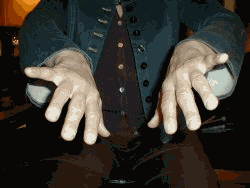 |
|
Articles |
There are two facets to improving your bongo playing: listening to rhythms and music until the rhythms are embedded inside you, and do repetitive hand exercises to give your hands the speed they need to let those rhythms out. The more you play, the better you play. Bongos are a soloing instrument, and solos are constructed of all of the ryhthmic pieces you have absorbed into your unconcious. If you have trained your hands along with your ears, the music will spring out before you have had a chance to think about it. L=left R=right Start with a basic single-stroke roll. L-R/L-R-etc. Only strike with the pads of your fingertips. Keep your movements economical and smooth. Try to pick one tempo and stick to it for as long as you can. Consistency at a slower speed will give the rolls you play later a professional smoothness. Then try a double-stroke roll. L-L-R-R/L-L-R-R-etc. Snare drumming uses multi-stroke rolls because the sticks bounce quickly off the drum head. It's harder for a bongo player to use these rolls because fingers don't bounce the same way. However the exercise is good for developing consistent control over your hand movements. Then try paradiddles. L-R-L-L-R-L-R-R/L-R-L-L-R-L-R-R-etc. It takes a minute to get accustomed to the pattern, but then it becomes easy. Again, aim for consistency of strength and tempo. Play with no accents on any of the beats. With any of these, try alternating between different fingertips. Next, practice the "manoteo", or "heel-toe". It's a four-stroke pattern, alternating the thumb and fingertips on each hand. "Heel" is the meaty base of your thumb, and "toe" is the fingertips. Hold your hands flat over the drumhead or tabletop. Push down with the base of your right thumb, then the left. Then let the fingertips of your right hand drop down as you raise your wrist, and then do the same on the left. The pattern is heel-heel-toe-toe. You don't have to put strength into it, just stay flexible. The movement is all in the wrists. Once you've got the pattern down, keep doing it for as long as you can. Play it as a smooth roll. Practice this one whenever you have a moment- it's invaluable for all types of hand drumming. Next you will want to work on your independance, which means playing two different time signiatures at the same time. Most Afro-Cuban-based music involves playing three against four, or six against eight. Tap out a slow, steady 1-2-3-4-1-2-3-4 with your foot, then play 1-2-3-1-2-3 as triplets with one hand, so that your hand and foot both land on the 1 at the same time consistently. It's helpful to have a metronome or drum machine to help you keep steady time. After you have acheived this for a while, then switch hands. Alternate between each of your hands and feet until each of them is able to play in 3 while the others stay in 4. It's a difficult process, very frustrating, but it will help you tremendously when you succeed. This is the basis of son clave. Half of the clave measure is in 4 time, and half is in triplet time. Son clave is referred to as 2/3 or 3/2 clave depending on whether the measure starts with the triplet section or not. It's a good idea to find a teacher in your area who can teach you the proper way to play clave. An extension of the independance exercise is to play clave with one hand or foot while keeping a steady 4/4 or 3/4 beat with the others. Or, you can call out the clave with your mouth "mm ta ta -- ta, ta, ta" while you play the martillo on your bongos. Be sure to practice the clave in both directions. Again, it helps to have a metronome so you maintain consistency. When you have mastered son clave, it's time to study rumba clave. There are several different claves in the rumba traditions, but the one associated with Guaguanco is often referred to as "rumba clave", and it is the most useful in jazz and other forms outside of traditional Cuban dance. It is hard to notate, so I recommend you buy some records by rumba groups such as Los Munequitos de Matanzas or Los Papines, and study them. Clap along with the clave while you listen, and eventually you will start to feel and understand how the drum patterns repeat and the rhythmic form pulses. This is a lifetime study by itself, but the practice is worth adding into your drumming exercises. When you have mastered all of these exercises, you will be pretty damn good on the bongos.
Here is a great exercise for developing flexibility and strength in your hands and wrists:
Rotate your hands and wrists along the lengthwise axis of your forearm. Keep the movement smooth and consistent, and go as fast as you feel comfortable (the image here may play slowly, but your rotations should be fairly fast). Do this for five minutes, before playing, to warm up. Also you can drum your thumb and the tip of your ring finger against any surface like a desk, steering wheel, or cardboard box. This will give you a good feel for how fast and consistent your motions are. It also allows you to see how your weaker hand compares to your stronger hand. Do this exercise frequently with your weaker hand, and you will see huge improvements in your drum rolls! Orlando Fiol suggested this exercise based on his training as a classical tabla player in India. |
| All contents of this site copyright 2004-2007 Cyrus Joaquin Heiduska, unless otherwise indicated | |
